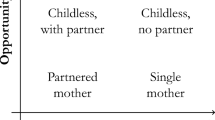Abstract
This paper analyses the transitions between the three states of non-employment, part-time and full-time work of a sample of married women living in West Germany. The questions addressed concern the dynamics of women's labour market transitions and the association of the probability of transition with household and individual characteristics. A non-parametric duration analysis shows that women have a similar attachment to full-time and part-time work in terms of survival, and that survival in non-employment is shorter than in the other two states. Estimates of a parametric discrete-time competing risks duration model show that wives of retired husbands go into full-time work, children under 3 years have a disincentive effect on part-time work and that part-time work is a state that German women prefer to stay in and not a first step to full-time employment, whereas foreign women living in West Germany prefer full-time jobs.
Similar content being viewed by others
References
Adam P (1996) Mothers in an Insider-Outsider Economy: The Puzzle of Spain. Journal of Population Economics 9:301–323
Allison PD (1982) Discrete-Time Methods for the Analysis of Event Histories. In: Leinhardt S (ed) Sociological Methodology. Jossey-Bass, San Francisco
Blank RM (1989) The Role of Part-Time Work in Women's Labor Market Choices Over Time. The American Economic Review, Papers and Proceedings 79:295–299
Blank RM (1994) The Dynamics of Part-Time Work. NBER working paper, No. 4911
Ermisch J, Wright R (1991) Employment Dynamics among British Single Mothers. Oxford Bulletin of Economics and Statistics 53:99–122
Ermisch J, Wright R (1993) Wage Offers and Full-Time and Part Time Employment of British Women. The Journal of Human Resources 28:111–133
Giannelli GC (1995) Women's Transitions in the Labour Market. A Competing Risks Analysis on German Panel Data. Studi e Discussioni, No. 95, October, Dipartimento di Scienze Economiche, Università di Firenze, Italy
Giannelli GC, Micklewright J (1995) Why do Women Married to Unemployed Men have Low Participation Rates? Oxford Bulletin of Economics and Statistics 57:471–486
Gustafsson SS, Wetzels C, Vlasbom JD, Dex S (1996) Women's Labor Force Transitions in Connection with Childbirth. A Panel Data Comparison between Germany, Sweden and Great Britain. Journal of Population Economics 9:223–246
Hanefeld U (1987) Das Sozio-ökonomische Panel. Grundlagen and Konzeption. Campus Verlag, Frankfurt
Jenkins SP (1995) Easy Estimation Methods for Discrete Time Duration Models. Oxford Bulletin of Economics and Statistics 57:129–137
Joshi H, Macran S, Dex S (1996) Employment after Childbearing and Women's Subsequent Labour Force Participation: Evidence from the British 1958 Birth Cohort. Journal of Population Economics 9:325–348
Kaplan EL, Meier P (1958) Nonparametric Estimation from Incomplete Observations. Journal of the American Statistical Association 53:457–481
Kell M, Wright J (1990) Benefits and the Labour Supply of Women Married to Unemployed Men. Economic Journal, Conference Papers Supplement, 119–126
Killingsworth MR (1983) Labor supply. Cambridge University Press, New York
Lancaster T (1990) The Econometric Analysis of Transition Data. Cambridge University Press, New York
Mantel N (1966) Evaluation of Survival Data and Two new Rank Order Statistics Arising in its Consideration. Cancer Chemotherapy Reports 50:163–170
Mroz AT (1987) The Sensitivity of an Empirical Model of Married Women's Hours of Work to Economic and Statistical Assumptions. Econometrica 55:765–799
Nakamura A, Nakamura M (1983) Part-time and Full-Time Work Behaviour of Married Women. Canadian Journal of Economics 16:229–257
Nakamura A, Nakamura M (1994) Predicting Female Labor Supply, Effects of Children and Recent Work Experience. The Journal of Human Resources 29:304–327
Rohwer G (1993) Analysis of Transition Data: A Practical Introduction with TDA. Department of Sociology, University of Bremen
Author information
Authors and Affiliations
Additional information
I thank Rebecca Blank, John F. Ermisch, Siv Gustafsson, John Micklewright, Pravin Trivedi, Jane Waldfogel and two anonymous referees for helpful discussions and comments, and Hans-Peter Blossfeld for providing access to these data through his research project at the European University Institute of Florence. Responsible editors: Siv S. Gustafsson, John F. Ermisch
Rights and permissions
About this article
Cite this article
Giannelli, G.C. Women's transitions in the labour market: A competing risks analysis on German panel data. J Popul Econ 9, 287–300 (1996). https://doi.org/10.1007/BF00176689
Received:
Accepted:
Issue Date:
DOI: https://doi.org/10.1007/BF00176689




